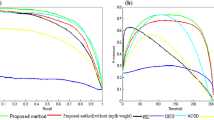Abstract
In this paper, a diversity-induced multi-view matrix decomposition model (DMMD) for salient object detection is proposed. In order to make the background cleaner, \(\mathrm {Schatten}\)-p norm with an appropriate value of p in (0,1] is used to constrain the background part. A group sparsity induced norm is imposed on the foreground (salient part) to describe potential spatial relationships of patches. And most importantly, a diversity-induced multi-view regularization based Hilbert-Schmidt Independence Criterion (HSIC), is employed to explore the complementary information of different features. The independence between the multiple features will be enhanced. The optimization problem can be solved through an augmented Lagrange multipliers method. Finally, high-level priors are merged to boom the salient regions detection. Experiments on the widely used MSRA-5000 dataset show that the DMMD model outperforms other state-of-the-art methods.
Access this chapter
Tax calculation will be finalised at checkout
Purchases are for personal use only
Similar content being viewed by others
References
Zuo, W., Meng, D., Zhang, L., Feng, X., Zhang, D.: A generalized iterated shrinkage algorithm for non-convex sparse coding. In: ICCV, pp. 217–224 (2013)
Yan, Q., Xu, L., Shi, J., Jia, J.: Hierarchical saliency detection. In: CVPR, pp. 1155–1162 (2013)
Yang, C., Zhang, L., Lu, H., Ruan, X., Yang, M.: Saliency detection via graph-based manifold ranking. In: CVPR, pp. 3166–3173 (2013)
Perazzi, F., Krähenbühl, P., Pritch, Y., Hornung, A.: Saliency filters: Contrast based filtering for salient region detection. In: CVPR, pp. 733–740 (2012)
Jiang, H., Wang, J., Yuan, Z., Liu, T., Zheng, N., Li, S.: Automatic salient object segmentation based on context and shape prior. In: BMVC (2011)
Shen, X., Wu, Y.: A unified approach to salient object detection via low rank matrix recovery. In: CVPR, pp. 853–860 (2012)
Cheng, M.-M., Zhang, G., Mitra, N.J., Huang, X., Hu, S.-M.: Global contrast based salient region detection. In: CVPR, pp. 409–416 (2011)
Chang, K.-Y., Liu, T.-L., Chen, H.-T., Lai, S.-H.: Fusing generic objectness and visual saliency for salient object detection. In: ICCV, pp. 914–921 (2011)
Zhu, W., Liang, S., Wei, Y., Sun, J.: Saliency optimization from robust background detection. In: CVPR, pp. 2814–2821 (2014)
Liu, G., Lin, Z., Yu, Y.: Robust subspace segmentation by low-rank representation. In: ICML, pp. 663–670 (2010)
Lang, C., Liu, G., Yu, J., Yan, S.: Saliency detection by multitask sparsity pursuit. IEEE Trans. Image Process. 21, 1327–1338 (2012)
Zou, W., Kpalma, K., Liu, Z., Ronsin, J.: Segmentation driven low-rank matrix recovery for saliency detection. In: BMVC (2013)
Candès, E., Li, X., Ma, Y., Wright, J.: Robust principal component analysis? J. ACM 58, 11–20 (2011)
Lin, Z., Chen, M.-M., Ma, Y.: The augmented lagrange multiplier method for exact recovery of corrupted low-rank matrices. arXiv preprint arxiv:1009.5055 (2010)
Peng, H., Li, B., Ji, R., Hu, W., Xiong, W., Lang, C.: Salient object detection via low-rank and structured sparse matrix decomposition. In: AAAI, pp. 796–802 (2013)
Simoncelli, E., Freeman, W.: The steerable pyramid: A flexible architecture for multi-scale derivative computation. In: ICIP (1995)
Feichtinger, H.G., Strohmer, T.: Gabor Analysis and Algorithms: Theory and Applications. Birkhäuser, Basel (2012)
Achanta, R., Shaji, A., Smith, K., Lucchi, A., Fua, P., Susstrunk, S.: SLIC superpixels compared to state-of-the-art superpixel methods. IEEE Trans. Pattern Anal. Mach. Intell. 12, 2274–2282 (2012)
Felzenszwalb, P., Huttenlocher, D.: Efficient graph-based image segmentation. Int. J. Comput. Vis. 59, 167–181 (2004)
Cetin, M., Karl, W.C.: Feature-enhanced synthetic aperture radar image formation based on nonquadratic regularization. IEEE Trans. Image Process. 10, 623–631 (2001)
Chartrand, R.: Exact reconstruction of sparse signals via nonconvex minimization. IEEE Sig. Process. Lett. 14, 707–710 (2007)
Chartrand, R., Staneva, V.: Restricted isometry properties and nonconvex compressive sensing. Inverse Prob. 24, 657–682 (2008)
Cao, X., Zhang, C., Fu, H., Liu, S., Zhang, H.: Diversity-induced multi-view subspace clustering. In: CVPR, pp. 586–594 (2015)
Peng, H., Li, B., Ling, H., Hu, W., Xiong, W., Maybank, S.J.: Salient object detection via structured matrix decomposition. IEEE Trans. Pattern Anal. Mach. Intell. (2016). In Press
Chaudhuri, K., Kakade, S.M., Livescu, K., Sridharan, K.: Multi-view clustering via canonical correlation analysis. In: ICML, pp. 129–136 (2009)
Tang, W., Lu, Z., Dhillon, I.S.: Clustering with multiple graphs. In: ICDM, pp. 1016–1021 (2009)
Cai, D., He, X., Han, J., Huang, T.S.: Graph regularized nonnegative matrix factorization for data representation. IEEE Trans. Pattern Anal. Mach. Intell. 33, 1548–1560 (2011)
Tong, N., Lu, H., Ruan, X., Yang, M.-H.: Salient object detection via bootstrap learning. In: CVPR, pp. 1884–1892 (2015)
Li, X., Lu, H., Zhang, L., Ruan, X., Yang, M.-H.: Saliency detection via dense and sparse reconstruction. In: ICCV, pp. 2976–2983 (2013)
Zhang, X., Sun, X., Xu, C., Baciu, G.: Multiple feature distinctions based saliency flow model. Pattern Recogn. 54, 190–205 (2016)
Zhang, X., Xu, C., Sun, X., Baciu, G.: Schatten-q regularizer constrained low rank subspace clustering model. Neurocomputing 182, 36–47 (2016)
He, Z., Sun, X., Zhang, X., Xu, C.: Saliency detection via nonconvex regularization based matrix decomposition. In: International Conference on Computational Intelligence and Security, pp. 243–247 (2015)
Acknowledgement
This work is supported in part by the National Natural Science Funds of China (Grant Nos. 61472257, 61402290, 61401287) and in part by the Natural Science Foundation of Shenzhen under Grant JCYJ 20160307154003475 and 2016050617251253.
Author information
Authors and Affiliations
Corresponding author
Editor information
Editors and Affiliations
Rights and permissions
Copyright information
© 2017 Springer International Publishing AG
About this paper
Cite this paper
Sun, X., He, Z., Zhang, X., Zou, W., Baciu, G. (2017). Saliency Detection via Diversity-Induced Multi-view Matrix Decomposition. In: Lai, SH., Lepetit, V., Nishino, K., Sato, Y. (eds) Computer Vision – ACCV 2016. ACCV 2016. Lecture Notes in Computer Science(), vol 10111. Springer, Cham. https://doi.org/10.1007/978-3-319-54181-5_9
Download citation
DOI: https://doi.org/10.1007/978-3-319-54181-5_9
Published:
Publisher Name: Springer, Cham
Print ISBN: 978-3-319-54180-8
Online ISBN: 978-3-319-54181-5
eBook Packages: Computer ScienceComputer Science (R0)




